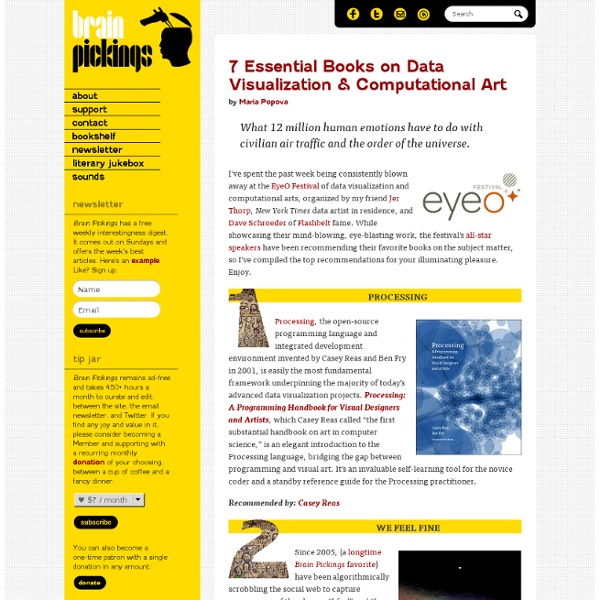7 Essential Books on Data Visualization & Computational Art

Visualizing Del.icio.us Roundup
I have been coming across many del.icio.us tools to visualize usage during my daily researching hours. So many, that I have decided to start making note of the ones I come across. From the span of about two weeks, I have been collecting as many as I could find. I will list each one along with a description. Enjoy! There’s a couple more that I have in mind, but they don’t seem to be working at the moment.
Bime - Analytics & Dashboards | SAAS Business Intelligence |
From startup to fortune 500 Accessibility, fair pricing, infinite scalability, premium support. There is something for everyone in here. From web analysts to CFOs Whether you are a web analyst, in marketing, financial accountant or anything else, turn your data into actionable information. Power pack From a full-blown Business Intelligence stack to extending your existing one. WEBINAR: Introduction to BIME An introduction to BIME which will provide attendees with everything they need to know to start building stunning dashboards and doing data discovery. Thursday 10th of April 2014 at 11:00 EDT WEBINAR: How E-Commerce becomes Smart Commerce Learn how to use cloud BI to do an in-depth analysis of your online sales channels - from websites to widgets and apps. Thursday 17th of April 2014 at 11:00 EDT Including connectors for Google BigQuery, relational databases, spreadsheets, flat files, OLAP engines, Google Analytics, Facebook Insights, Salesforce CRM and Google Spreadsheets...
Visual Gadgets
Search engine data visualisations « Search insights
I’ve decided I need a single place to put all of the search engine data visuals that I’ve been working on. The visuals are made up of thousands of actual queries put into search engines by UK users over the course of a year. This gives us an idea of ‘search demand’ which can/may/should equal actual, offline demand for a topic. Feel free to republish however please link to this blog and also to James Webb who helped to create them. They can be downloaded as PDF’s at the bottom of this page. Click the links below to open the visuals in PDF format for better quality printing / viewing. Overall Gardening Health Science Nature History Questions Like this: Like Loading...
Data Visualization Software – Link & Data Analysis by Centrifuge Systems
Gephi
Emergent Futures Mapping with Futurescaper
Futurescaper is an online tool for making sense of the drivers, trends and forces that will shape the future. As a user interface system, it still needs development. As a tool for analyzing and understanding complex systems, it works very well and does something I have yet to see anything else be able to do. Several people asked me about this after my last post, so here is some more detail. Following the logic of collective intelligence (as part of my my PhD), I broke up the the scenario thinking process into discrete chunks, came up with a system for analyzing and relating them together, and then distilled them into key outputs for helping the scenario development process. Emergent Thematic Maps One of the coolest things about Futurescaper is how it translates simple input into complex analysis, and then back again into simple insights. To demonstrate this, I tested the system using data from an International Futures Forum project on international climate change impacts for UK Foresight.
Thinkmap visualization software facilitates communication, learning, and discovery.
Related:
Related:



